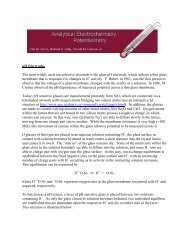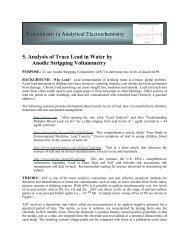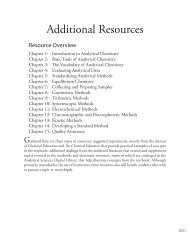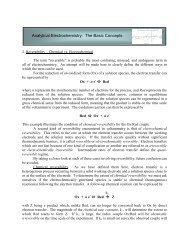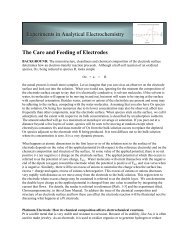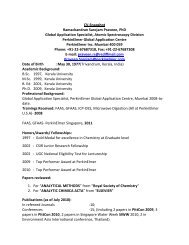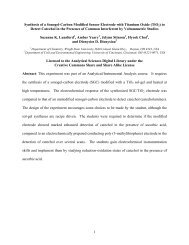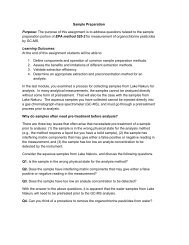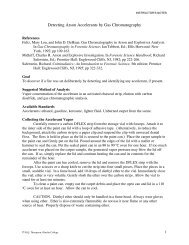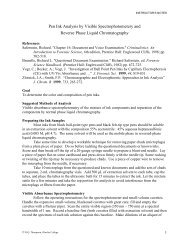1072 Analytical Chemistry 2.0<strong>Appendix</strong> 1: NormalityNormality expresses concentration in terms of the equivalents of one chemical species reacting stoichiometricallywith another chemical species. Note that this definition makes an equivalent, and thus normality, afunction of the chemical reaction. Although a solution of H 2 SO 4 has a single molarity, its normality dependson its reaction.We define the number of equivalents, n, using a reaction unit, which is the part of a chemical species participatingin the chemical reaction. In a precipitation reaction, for example, the reaction unit is the charge ofthe cation or anion participating in the reaction; thus, for the reactionPb 2+ (aq) + 2I – (aq) PbI 2 (s)n = 2 for Pb 2+ (aq) and n = 1 for 2I – (aq). In an acid–base reaction, the reaction unit is the number of H + ionsthat an acid donates or that a base accepts. For the reaction between sulfuric acid and ammoniaH 2 SO 4 (aq) + 2NH 3 (aq) 2NH 4 + (aq) + SO 4 2– (aq)n = 2 for H 2 SO 4 (aq) because sulfuric acid donates two protons, and n = 1 for NH 3 (aq) because each ammoniaaccepts one proton. For a complexation reaction, the reaction unit is the number of electron pairs that themetal accepts or that the ligand donates. In the reaction between Ag + and NH 3Ag + (aq) + 2NH 3 (aq) Ag(NH 3 ) 2 + (aq)n = 2 for Ag + (aq) because the silver ion accepts two pairs of electrons, and n = 1 for NH 3 because each ammoniahas one pair of electrons to donate. Finally, in an oxidation–reduction reaction the reaction unit is thenumber of electrons released by the reducing agent or accepted by the oxidizing agent; thus, for the reaction2Fe 3+ (aq) + Sn 2+ (aq) Sn 4+ (aq) + 2Fe 2+ (aq)n = 1 for Fe 3+ (aq) and n = 2 for Sn 2+ (aq). Clearly, determining the number of equivalents for a chemical speciesrequires an understanding of how it reacts.Normality is the number of equivalent weights, EW, per unit volume. An equivalent weight is the ratio ofa chemical species’ formula weight, FW, to the number of its equivalents, n.EW=FW nThe following simple relationship exists between normality, N, and molarity, M.N = n×M
<strong>Appendix</strong> 2: Propagation of UncertaintyAppendicesIn Chapter 4 we considered the basic mathematical details of a propagation of uncertainty, limiting our treatmentto the propagation of measurement error. This treatment is incomplete because it omits other sources ofuncertainty that influence the overall uncertainty in our results. Consider, for example, Practice Exercise 4.2,in which we determined the uncertainty in a standard solution of Cu 2+ prepared by dissolving a known massof Cu wire with HNO 3 , diluting to volume in a 500-mL volumetric flask, and then diluting a 1-mL portionof this stock solution to volume in a 250-mL volumetric flask. To calculate the overall uncertainty we includedthe uncertainty in the sample's mass and the uncertainty of the volumetric glassware. We did not considerother sources of uncertainty, including the purity of the Cu wire, the effect of temperature on the volumetricglassware, and the repeatability of our measurements. In this appendix we take a more detailed look at thepropagation of uncertainty, using the standardization of NaOH as an example.Standardizing a Solution of NaOH 1Because solid NaOH is an impure material, we cannot directly prepare a stock solution by weighing a sampleof NaOH and diluting to volume. Instead, we determine the solution's concentration through a process calleda standardization. 2 A fairly typical procedure is to use the NaOH solution to titrate a carefully weighed sampleof previously dried potassium hydrogen phthalate, C 8 H 5 O 4 K, which we will write here, in shorthand notation,as KHP. For example, after preparing a nominally 0.1 M solution of NaOH, we place an accurately weighed0.4-g sample of dried KHP in the reaction vessel of an automated titrator and dissolve it in approximately 50mL of water (the exact amount of water is not important). The automated titrator adds the NaOH to the KHPsolution and records the pH as a function of the volume of NaOH. The resulting titration curve provides uswith the volume of NaOH needed to reach the titration's endpoint. 3The end point of the titration is the volume of NaOH corresponding to a stoichiometric reaction betweenNaOH and KHP.− + +NaOH + CHOK→ CHO4 + K + Na + HO()l8 5 4 8 4 2Knowing the mass of KHP and the volume of NaOH needed to reach the endpoint, we use the followingequation to calculate the molarity of the NaOH solution.1000× m × PM × VKHP KHPC NaOH=KHPwhere C NaOH is the concentration of NaOH (in mol KHP/L), m KHP is the mass of KHP taken (in g), P KHPis the purity of the KHP (where P KHP = 1 means that the KHP is pure and has no impurities), M KHP is themolar mass of KHP (in g KHP/mol KHP), and V NaOH is the volume of NaOH (in mL). The factor of 1000simply converts the volume in mL to L.Identifying and Analyzing Sources of UncertaintyAlthough it seems straightforward, identifying sources of uncertainty requires care as it easy to overlook importantsources of uncertainty. One approach is to use a cause-and-effect diagram, also known as an Ishikawa1 This example is adapted from Ellison, S. L. R.; Rosslein, M.; Williams, A. EURACHEM/CITAC Guide: Quantifying Uncertainty in AnalyticalMeasurement, 2nd Edition, 2000 (available at http://www.measurementuncertainty.org/).2 See Chapter 5 for further details about standardizations.3 For further details about titrations, see Chapter 9.NaOH1073



